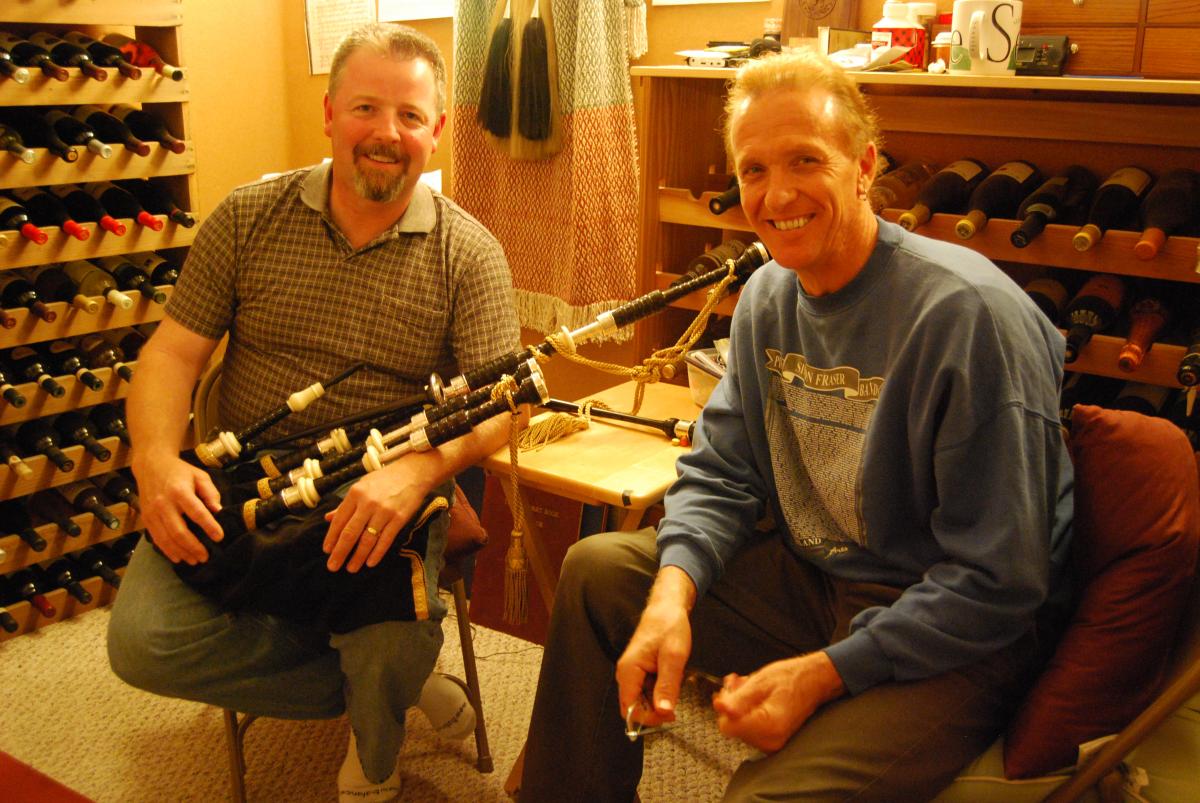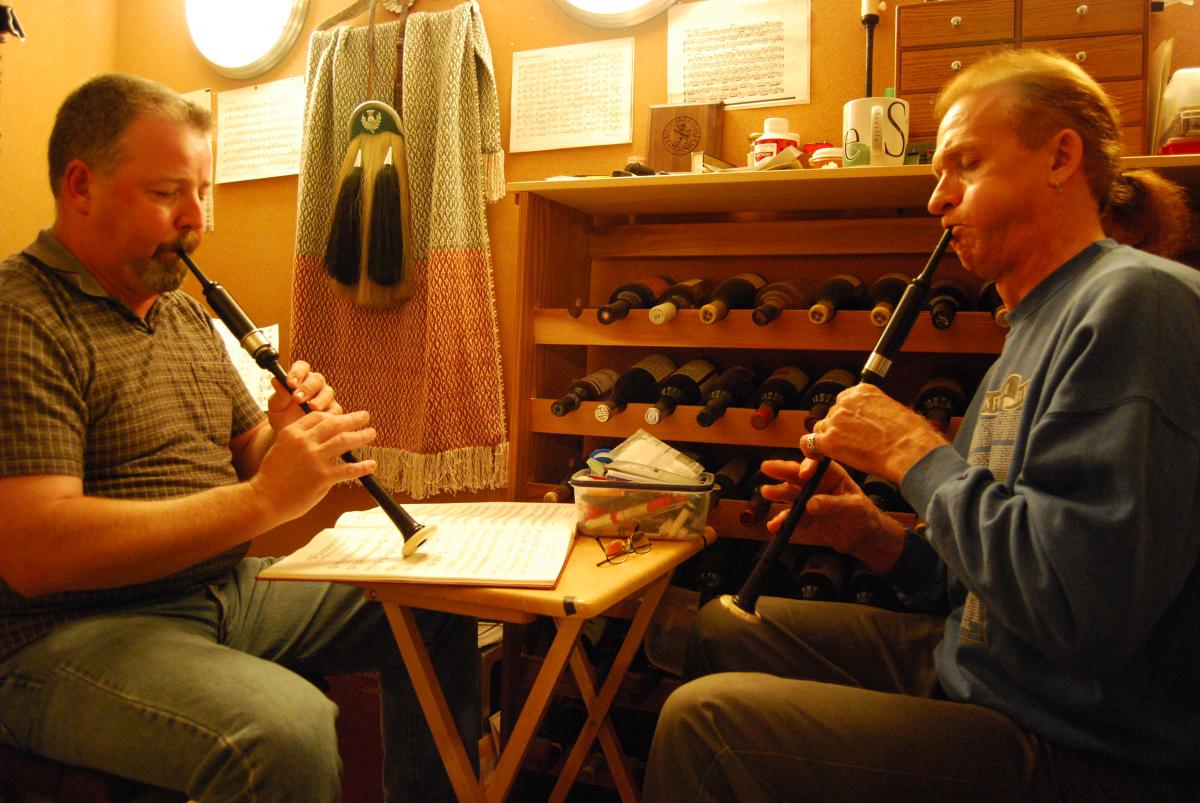 Master Highland bagpiper Ian Whitelaw of Redondo Beach is a current participant in the Alliance for California Traditional Arts’ Apprenticeship Program with apprentice Earl Braten of Tracy. The focus of their apprenticeship is on the Scottish Highland bagpiping musical tradition of Piobaireachd, a form of music which had been well developed by the late 16th century in Scotland. The apprenticeship focuses on Braten’s memorization of up to four of the pieces, one at a time, and learning the nuances and depth contained in the music, under Whitelaw’s guidance.
Master Highland bagpiper Ian Whitelaw of Redondo Beach is a current participant in the Alliance for California Traditional Arts’ Apprenticeship Program with apprentice Earl Braten of Tracy. The focus of their apprenticeship is on the Scottish Highland bagpiping musical tradition of Piobaireachd, a form of music which had been well developed by the late 16th century in Scotland. The apprenticeship focuses on Braten’s memorization of up to four of the pieces, one at a time, and learning the nuances and depth contained in the music, under Whitelaw’s guidance.
Compared to band and march piping, which focus on group playing and technical precision, Piobaireachd lacks a set tempo and is generally played by a soloist, emphasizing subtle personal interpretations and more freedom within the music confines of what is played. There are over 350 known songs (each song averaging 15-minutes long) in the traditional Piobaireachd repertory, a repertory which has martial roots from the Western Isles and is typically passed on orally, requiring complete memorization. While written notation exists, it has limitations to capture the richness, interpretation and soulfulness of the form. Whitelaw elaborates: “This is all music of finesse. There’s no force here. The bagpipe is unique in that we don’t have any other way to express the music except to hold the notes – like a radio you can never turn off. All we can do is hold the notes, so the note values on paper aren’t the notes played… the trick is to teach the student just how long to hold the note, to be able to express it, sound musical. It has to be beautiful, tuned, and blown manageably, several things at the same time – and then all of it memorized.”
“This music allows the instrument to tell the story. Because the bagpipe is all about sound, about how it sounds to the person listening. This particular type of music has long notes so it gives you the opportunity to bask in the sound of the note. That’s what stirs people. It’s not really the melody. It’s always how it sounds. Sound makes you feel a certain way.”
“You only have nine notes to make all those pieces [in the Piobaireachd repertory] sound different,” Braten adds.
Whitelaw, who knows approximately 150 of those songs, was taught by revered bagpiper Andrew Wright of Scotland’s Piobaireachd Society, whom Whitelaw has worked with over the past 30 years and considers “one of the all-time virtuoso musicians, one of a kind.” The musical tradition itself draws from classical bagpipe music, and each song is structured around a specific musical theme or “ground,” opening with the simple theme, slowly building through melodic passages, and returning to the ground by the end. However, Piobaireachd music differs from classical bagpipe music in its playing technique, slower pace, and its distinct musical movements.
Originally played for lamenting the death in a family, saluting a new birth, honoring a community gathering, or punctuating wartime, Piobaireachd emerged out of the Highland clan system which generations ago would involve a bard commemorating a clan-oriented battle or a person, followed by Piobaireachd. “When the clan system failed [in approximately the middle of the 18th century] Piobaireachd started to die out,” Whitelaw explains, “so the British Army invented the competition, the Piobaireachd Society came up with the idea to have a competition and that would force people to play it.” Competitions indeed have been critical to the perpetuation and development of Piobaireachd to this day – including three annual major competitions in Scotland – and, along with funerals, are the most common contemporary context where Piobaireachd is heard. Competitions also are important for gold medal-winning master pipers like Whitelaw to increase their visibility and their artistry, though Whitelaw emphasizes that the passion for the music and depth of artistry in the form precedes any sort of prestige: “For me it is not about the prizes. I’ve studied the music, I’ve studied the composers. I want to know what makes it good. It’s important for me to get it right. I don’t want to just memorize it.”
Considered an expert amongst pipers at getting the best sound out of the 4-reeded woodwind instrument, Whitelaw has focused the apprenticeship with Braten on setting up the pipes and working with sound quality, two fundamental characteristics of good piping. Manipulating and adjusting the chanter reed (made from cane) and chanter (typically made from hard African blackwood) are the biggest challenges to achieving a balanced sound, a process which Braten describes as “a lot more error than trial, unless you have Ian to work with.” Armed with the right tools – mandrel, sharp knife, sandpaper – Whitelaw says it has taken him forty years to understand how to manipulate the pipes.
 Their participation in the Apprenticeship Program has enabled Braten to deepen his intermittent studies with Whitelaw over the past ten years, and to hone in on Piobaireachd. “Ian has ways of explaining things that make sense musically, rather than just telling you to play the way it is written. He has a unique talent, a gift that he has for teaching.” The two met monthly for lessons which occurred in San Francisco and Fremont at home studios of fellow piper Harvey Yaw. In each of the lessons, Whitelaw would play a piece, introduce it in its entirety for Braten to record, and proceed to comb through a tune bit by bit, allowing Braten to play while Whitelaw listened carefully and gave feedback. Whitelaw wants to impart information to Braten via the direct sound, by allowing Braten to hear the music played, and then subsequently allowing Braten to “pick up on [Whitelaw’s] passion for it.”
Their participation in the Apprenticeship Program has enabled Braten to deepen his intermittent studies with Whitelaw over the past ten years, and to hone in on Piobaireachd. “Ian has ways of explaining things that make sense musically, rather than just telling you to play the way it is written. He has a unique talent, a gift that he has for teaching.” The two met monthly for lessons which occurred in San Francisco and Fremont at home studios of fellow piper Harvey Yaw. In each of the lessons, Whitelaw would play a piece, introduce it in its entirety for Braten to record, and proceed to comb through a tune bit by bit, allowing Braten to play while Whitelaw listened carefully and gave feedback. Whitelaw wants to impart information to Braten via the direct sound, by allowing Braten to hear the music played, and then subsequently allowing Braten to “pick up on [Whitelaw’s] passion for it.”
Braten himself is no novice, having played pipes for decades. With a musician father in the navy and a first generation Irish dance teacher as a mother coming from a line of traditional Irish musicians, Braten grew up with strong Celtic musical roots, and attended folk festivals and concerts. In the mid 1970s, he picked up the pipes after seeing San Francisco’s Prince Charles Pipe Band, a youth piping group which his own daughter currently plays in. After meeting Whitelaw ten years ago, Braten began to take lessons on and off from Whitelaw, and began to study Piobaireachd, a sharp contrast having come from a piping career focused on marches and band music. “When I was a kid I had no time for Piobaireachd, didn’t understand it, it didn’t excite me. Now as an adult I feel like I understand the music, I may not always be able to express it the way I want to, but it makes sense to me. Piobaireachd is definitely another level of music – an incredible, spiritual music. It takes you somewhere else. I can’t get enough. I’d be doing it everyday if I could.”
Whitelaw’s initial exposure to bagpiping and his ensuing passion for it echoes Braten’s, having been struck by a piper during a Scottish cultural fair when he was a boy. The piper he heard, one Alan Munn, was an 80-year old chain smoking musician who ended up introducing Whitelaw to the bagpipe, showing Whitelaw everything he could, and serving as an “amazing guide” for Whitelaw. “I couldn’t get the bagpipes out of my hands…couldn’t put them down. That’s all I wanted to do. Piobaireachd is life to me.”
Self-described as a “drill master,” Whitelaw describes Braten as a “terrific player” and is encouraging Braten to join major competitions in 2009. Their apprenticeship has contributed to Braten’s progress, and Braten is grateful that “talent and ability so close at hand” is available to him, despite the 500 mile difference between their homes—there are only a handful of master pipers in North America. According to Whitelaw, Braten is “more in control of what he’s doing. He’s able to be calm, have a moment of serenity to play the thing properly. Earl’s really good. And he gets it. He’s been around me long enough, and he knows about holding notes and the importance of holding the notes longer.”
“When your pipes are just singing and you can block everything out, it takes an incredible amount of concentration. You really feel like you’ve accomplished something when you finish [a piece]. And so just getting through without any mistakes, with everything going just right…that’s happening more often now than it did before.”
Ultimately, in addition to deepening his practice under Whitelaw’s guidance, Braten wants to pass the tradition on, to teach beginners and youth.
“Earl has a tremendous talent that he never could pursue due to money and time. I’m enormously proud of him,” Whitelaw beams. “He has a great set of hands… it just comes flowing out of him.” Braten jumps in, saying, “..and he shows me what to do with them.”
